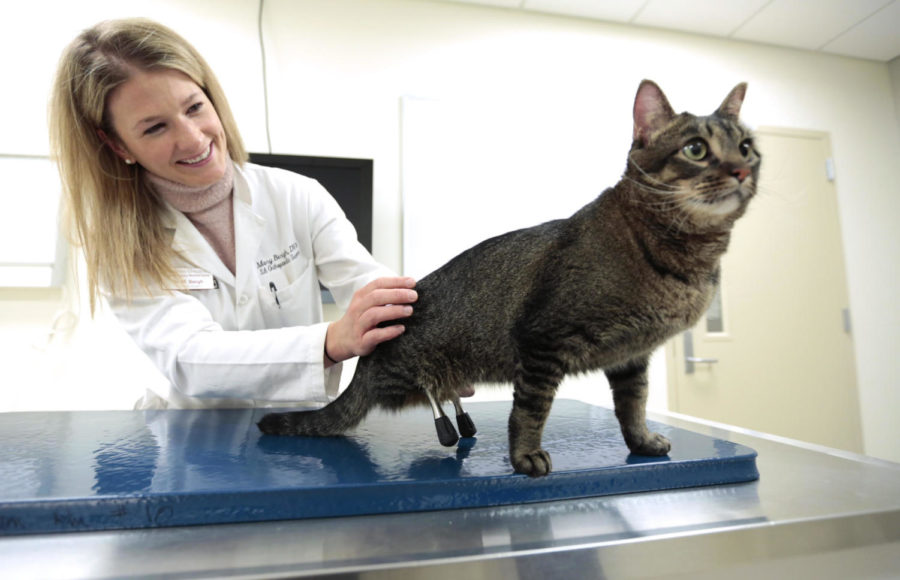ISU veterinarian gives cat new legs
December 10, 2015
One of the veterinarians at the College of Veterinary Medicine performed a surgery only completed on an estimated few dozen animals worldwide.
Dr. Mary Sarah Bergh, veterinary orthopedic surgeon and associate professor of veterinary clinical services, performed a major surgery on a 3-year-old cat named Vincent in February 2014 and then another a year later that helped the feline walk again.
Bergh said he is recovering well and has been able to walk on his new legs.
Vincent was found as a kitten missing part of his hind legs, just below the tibia. He was brought into the Story County Animal Shelter, where he was later adopted by Cindy Jones.
Vincent was brought to Bergh to see what she could do. She said they tried many different options before resorting to surgery.
“We tried physical therapy to improve range of motion,” Bergh said. “We also tried coverings, booties and even a wheelchair.”
After no luck with these options, prosthetics looked like the most reliable choice. BioMedtrix, a company that specializes in animal medical supplies, worked with Bergh to create implants. These implants were donated by the company.
Next, Bergh began preparing for surgery.
“There was a tremendous amount of preparation,” Bergh said. “There were lots of potential hiccups, so we rehearsed [the surgery].”
Once Vincent was ready for surgery, titanium rods that were designed by BioMedtrix were pounded in his femur bones. Part of his lower legs were amputated so that the rods would work easier.
Bergh estimated each leg took about an hour and a half in surgery. However, she said it was worth it.
“Vincent’s future looks a lot brighter now,” Bergh said. “Before [surgery], he had a likelihood of having a poor semi-normal life, but it looks better now.”
Vincent has very short metal rods implanted now but over time will eventually get longer ones. Bergh said short ones were originally implanted because they are easier to learn to walk with. There is an increased chance for more problems with the bone with longer rods.
Bergh also thinks this type of surgery is important in the future of animal prosthetics.
“It’s one step in a marathon,” Bergh said. “There’s lots to learn, and infection is a possible problem.”
Vincent has been reaching lots of people with his story. A video released on YouTube by ISU News Service has reached close to 700,000 views since Dec. 2. He has also had his story told through Buzzfeed, ABC News and The Huffington Post.
“People were very enthusiastic and amazed,” Bergh said. “People might now know that there is hope for animals with disabilities.”
Students from Vet Med were also excited for Bergh and Vincent.
“I am delighted that Dr. Bergh has chosen to make her career at Iowa State’s College of Veterinary Medicine,” said Lisa Nolan, dean of Veterinary Medicine. “She tackles challenging health problems every day with an expertise that is uniquely her own.”
Nolan also believes that this story could inspire people.
“I believe Vincent’s story will ensure that the public knows what our team can do, will inspire young people to pursue careers in veterinary medicine and give hope to pet lovers who have animals with health problems,” Nolan said.

















